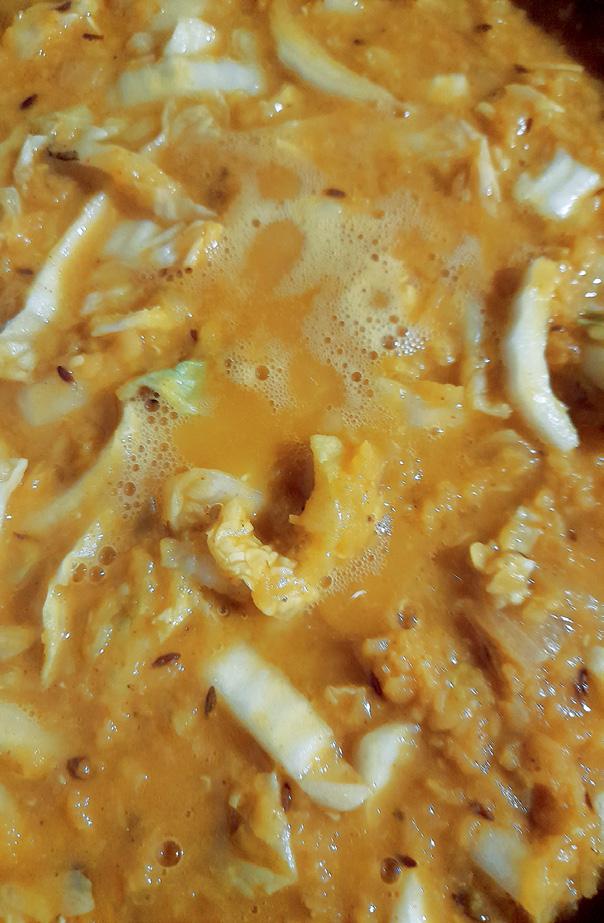
2 minute read
Vegan GF Winter Dahl
By Theresa Daley, Garden Island Creek, Tas.
cumin and coriander are good for digestion while cinnamon is warming and turmeric is anti-inflammatory – enjoy the benefits in this nourishing dish.
Advertisement
The weather is cooling and according to Ayurvedic wisdom we should eat foods that are easier to digest because our digestive fire isn’t as strong, it follows the arc and strength of the sun. Given that cooler weather also means more time indoors and less time involved in outdoor work and activities, food that is nourishing, yet easy to digest is just the thing, and this is where a good dahl reigns supreme. I was taught to make it by an Indian friend of mine, who is one of the best cooks in the world because she is an Indian mother.
The fresher your ingredients can be the better, including spices. I buy spices such as cumin in bulk and then grind some up for powder. I use cinnamon sticks and whole caraway seeds. If you have an aversion to garlic and/or onion you can substitute hing (asafoetida) which is a powder made from a large fennel like plant.
This dahl is cost effective, easy and quick to make with very little preparation.
red L enti L d a HL
3/ 4 cup dried red lentils, soaked and well rinsed
1/ 2 onion (or hing instead), chopped
1 tsp whole cumin seeds
1 tsp whole coriander seeds
1 cinnamon quill
2 tbsp olive oil or other neutral oil
1 tomato or 1 tbsp tomato paste salt to taste
1/2 tsp sugar
1 tsp ground cumin
1/4 tsp ground turmeric
1 or 2 vegies of choice, finely chopped – carrot, cabbage, broccoli, cauliflower, eggplant or any solid vegie you have on hand.
Soak the lentils in water for an hour or so then rinse well.
Cook the lentils in a saucepan on a medium heat with enough water for them to be swimming, you can add water but not take it out so keep that in mind. A scum will rise to the surface, remove this. You want quite a sloppy consistency at the end of cooking.
In a separate frypan with deepish sides, sauté the chopped onion and the whole spices, the cumin and coriander seeds and the cinnamon quill, in the oil. The oil should be hot but not too hot, you do not want it to burn. When the spices are dancing and you can smell them, and the onion is translucent, add the finely chopped tomato (or tomato paste and a little water), salt and sugar. Mix well and cover with a lid. Mix again and cook until all the ingredients have made a sauce, you may want to add a little water here and there, just a little at a time.
Now add in the powdered spices and mix well, cover and cook for another few minutes.
Add your cooked lentils and mix well. On low to medium heat cook the lentils and spices mix until well combined and infused. This will take a few minutes. Stir well as you cook and use a wooden utensil if possible.
Cover and leave on a low heat for a couple of minutes.
Now add the finely chopped vegies of choice. Keep in mind that carrot will cook more slowly than, say, wombok cabbage, so add in the carrot first.
Cook the dahl until the vegies are soft, but not squishy. Serve with freshly steamed rice for a delicious and nutritious meal that is cheap to make and aids digestion. Sprinkle with extra salt if you’d like.
It is a topic of great debate as to whether a dahl should be runny or thicker, if it should be served spicy with chilli, with pickle or not. It is a matter of individual taste and health. The rule of thumb is that if your dahl is more on the runny side it is easier to digest.
You can also cook some pappadums in the toaster for a fat free crunchy treat on the side. If you are thinking you might have some coconut yoghurt it would be wise to eat the dahl at lunch as yoghurt of any kind is difficult to digest.
And remember, dahl loves salt and we all love dahl! T










